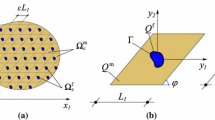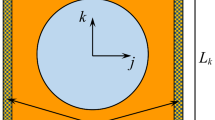Abstract
This paper presents a numerical procedure for the analysis of fiber-reinforced polymers, based on the application of an asymptotic homogenization method within the linear elastic domain that enables the mechanical characterization of the composite starting from the geometric and mechanical characteristics of its constituent materials. This method can then be used as a tool in the optimal design of the material for its structural use. The model proposed is 3D and envisages the possibility of modelling the composite as a periodic body in the direction orthogonal to the longitudinal development of the fibers. The results obtained from the homogenization procedure are compared with those from semi-empirical models in order to test the soundness of the model used. Furthermore, the homogenized model is capable of furnishing not only overall information on the stress fields in the body but also pointwise in the matrix and in the fibers.
Résumé
Dans ce travail on présente une procédure numérique pour l'analyse des polymères fibro-renforcés, fondée sur l'application d'une méthode asymptotique d'homogénéisation, en élasticité linéaire, qui permet la caractérisation mécanique du composite à partir des caractéristiques mécaniques et géométriques de ses matériaux constituants. Cette méthode peut donc être utilisée comme un outil dans la conception du matériau pour son utilisation optimale. Le modèle proposé est en 3D et permet la modélisation du composite comme un milieu périodique dans la direction perpendiculaire au développement longitudinal de ses fibres. Les résultats obtenus par la procédure d'homogénéisation sont comparés à ceux obtenus par des modèles semiempiriques afin de tester la validité du modèle homogénéisé proposé. De plus on souligne l'intérêt du modèle homogénéisé pour fournir non seulement des données macroscopiques sur les champs de contrainte, mais aussi des données locales sur la distribution des tensions dans la matrice et dans les fibres.
Similar content being viewed by others
References
Bank, L. C., ‘Properties of FRP reinforcement for concrete’, in ‘Fiber-Reinforced-Plastic (FRP) Reinforcement for Concrete Structures: Properties and Applications’, edited by Nanni A. (Elsevier, New York, 1993).
Agarwal, B. D. and Broutman, L. J., ‘Analysis ans performance of fiber composites’, (John Wiley & Sons, New York, 1990).
Luciano, R. and Barbero, E. J., ‘Formulas for the stiffness of composites with periodic microstructure’,Int. J. Solids Structures 31 (1994) 2933–2944.
Paul, B., ‘Predictions of elastic constants of mutiphase materials’,Transact. Metallurg. Soc. AIME (February 1960) 36–41.
Hashin, Z. and Shtripkman, S., ‘On some variational principles in anisotropic and nonhomogeneous elasticity’,J. Mech. Phys. Solids 10 (1962) 335–342.
Hashin, Z., ‘The elastic moduli of heterogeneous materials’,J. Mech. Phys. Solids 11 (1963) 127–140.
Hashin, Z. and Rosen, B. W., ‘The elastic moduli of fiber-reinforced materials’,J. Appl. Mech. 31 (1964) 223–230.
Kurshin, L. M. and Fil'shtinskii, L. A., ‘Determination of reduced elastic moduli of an isotropic plane, weaker by a doubly-periodic array of circular holes’,Prik. Mat. Mekh. 28 (1964) 4–30.
Chen, P. E. and Lin, J. M., ‘Transverse properties of fibrous composites’,Mater. Res. Stand. MSTRSA 9 (1969) 29–33.
Hashin, Z., ‘Analysis of composite materials: A survey’,J. Appl. Mech. 50 (1963) 481–505.
Hill, R., ‘Theory of mechanical properties of fibre-strengthtened materials: III. Self consistent model’,J. Mech. Solids 13 (1965) 89–101.
Willis, J. R., ‘The overall response of composite materials’,Advanced in. Appl. Mech. 21 (1983) 1–78.
Castañeda, N. N. and Suquet, P., ‘Non linear composite’,Advanced in Appl. Mech. 34 (1995) 172–295.
Sanchez-Hubert, J. and Sanchez-Palencia, E., ‘Introduction aux méthodes asymptotiques et à l'homogénéisation’, Masson, Paris, 1992).
Sanchez-Palencia, E. and Zaoui, A. (editors), ‘Homogeneization techniques for composite media’,Lecture Notes 272 (Springer, Berlin, 1987).
Cecchi, A. and Di Marco, R., ‘Homogeneization of masonry walls with a numerical oriented procedure. Rigid or elastic blocks?’,Eur. Jour. Mech. A/Solids 19 (2000) 535–546.
Anthoine, A., “Derivation of in plane elastic characteristic of masonry through homogenization theory’,Int. J. Solid Structures 32 (1995) 137–163.
Luciano, R. and Sacco, E., ‘Variational methods for the homogenization of periodic heterogeneous media’,Eur. J. Mech. A/Solids 17 (1998) 599–617.
Manual Design MMFG, ‘Morrison Molded Fiber Glass Co.’, (Bristol, Va, 1989).
Author information
Authors and Affiliations
Rights and permissions
About this article
Cite this article
Cecchi, A., Di Marco, R. Homogenization of FRP pultruded elements: a computational procedure for designing composite materials. Mat. Struct. 34, 378–384 (2001). https://doi.org/10.1007/BF02486490
Received:
Accepted:
Issue Date:
DOI: https://doi.org/10.1007/BF02486490




